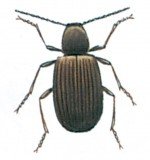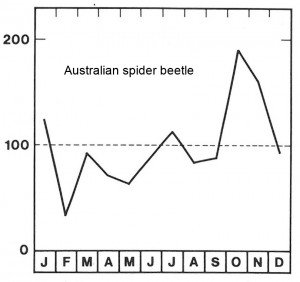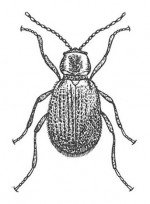Latin: Ptinus tectus.


Originates from the temperate zone of the southern hemisphere, namely Tasmania and New Zealand. It came to Europe around the year 1900, and found itself so comfortable on the northern hemisphere, that it drove away the more common, white-marked spider beetle. It is now widespread all over the world. The adult beetle is 3-4 mm long and reddish brown. Elytrons are densely covered with short hair. The larvae are 3-5 mm long, yellowish white with dark heads.
They are curved and have small legs. An adult female lays about 1000 eggs in a lifetime. The eggs are sticky and are laid on the things larvae can live on, that is, all kinds of dried plants: corn, feed, flour, grains, cocoa, spices and herbal substances. MBM is also suitable. On ceilings and empty warehouses, Australian spider beetles can live of insect remains as well as mouse and rat droppings. Australian spider beetles can also live in birds’ nests and dry carrion. When the larvae have become so big that they are ready to pupate, they leave the food. They can, just as the adults, chew through packaging to get out. The holes they leave are circular. The larvae seek out a sheltered spot where they spin a whitish tissue paper-like cocoon and pupate. Sometimes they eat the substrate, for example, in wood to make the right spot for the cocoon.

Australian spider beetles thrive at temperatures around 24 ° C. Below 10 ° C development and reproduction stops. The adult beetles are active at lower temperatures, down to 2 ° C. At room temperature, development from egg to adult lasts 3-4 months. At lower temperatures, it will take longer time. Adult spider beetles are shady and nocturnal. They infest the same types of products as the larvae, but – unlike those – also infest woollen textiles.




